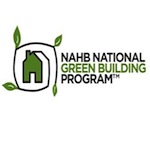NAHB Green Building Standard

National Green Building Program By The NAHB
The National Association of Home Builders (NAHB), the nation's leading builder's organization, has established the NAHB Green Building Standard in an effort to establish a credible, nationally-recognized green standard for new or existing buildings, including family homes.
As more people become interested in building super-efficient, environmentally-friendly homes, it is important that your home's designer and builder are knowledgeable about building green, and not just jumping on the eco-bandwagon. The NAHB green certification, officially called the ICC 700 National Green Building Standard, defines green building for homeowners, home designers, and builders alike. While defining standards for new homes, renovation projects, and site development projects, the Standard also allows great flexibility for regionally-appropriate 'best green' practices, as well as the needs of the home buyer.
NAHB Green Home Certification: A Quick Overview
A home can attain one of four levels of certification: Bronze, Silver, Gold, and Emerald, depending on how many green practices are incorporated into the design and construction of the home. At the Emerald level, the highest rating for homes, the building must achieve energy savings of 60% or more compared to a home built to minimum code requirements.
The NAHB Green Standard assigns point values to green practices, which are then accumulated in each of the following categories to achieve one of the four levels of certification:
- Lot & Site Development
- Resource Efficiency
- Energy Efficiency
- Water Efficiency
- Indoor Environmental Quality
- Homeowner Education
To comply with the NAHB standards, builders (or remodelers) must include a minimum number of features in each category. To move from one level of certification to the next higher (Bronze to Silver to Gold, etc.), a home must accumulate successively higher levels of the minimum points in each category.
How to Build a NAHB Green Building Standard Certified Home
In order for your home to achieve the NAHB green certification, it must be designed and built by a Certified Green Professional. Home designers, builders and remodelers must take classes and be certified by the NAHB Research Center. This allows them to demonstrate to their customers their expertise and knowledge in green building.
The NAHB Certified Green Professional will be able to incorporate the latest green building principles into your home, without significantly increasing the overall cost of construction.
The NAHB Green Building-certified home starts with a quality plan. All of the home plans offered by Green Home Source are designed by a certified NAHB Green Professional architect for maximum efficiency and sustainability.
After you've chosen a green home plan, it will be time to find a participating NAHB Green builder. These can be found by searching the database at the NAHB Green website.
Home Verification and Certification
Finally, you will need to have your green home (or renovation) verified by the NAHB. Here are the steps to complete:
- Tabulate the home's final green score with the online Green Scoring Tool or downloadable spreadsheet.
- Hire an NAHB accredited verifier.
- Forward the Scoring spreadsheet or Designer's Report to the selected verifier and schedule a rough inspection.
- A Builder's Agreement will be sent by the NAHB Research Center to all participants once the rough inspection has been scheduled. The Program Participation Agreement with completed application form, proof of insurance, and the certification fee (about $200) must be submitted to the Research Center. (You didn't think this was all FREE, did you?)
- After the verifier's rough inspection, you will meet with them to sign the Verification Report, which is sent to the Research Center for review.
- Schedule a final inspection with the verifier, and sign the final Verification Report.
- All reports and information will be reviewed by the Research Center, which will then finally issue the Certified Green Home certificate.
If the whole certification process seems complicated, don't worry. For new homes, the designer and builder will actually take care of filling out and processing all necessary paperwork directly with the NAHB. The result, in the end, is a home certified to be efficient, with a much lower impact on the environment.
comments powered by Disqus

























































































































































































